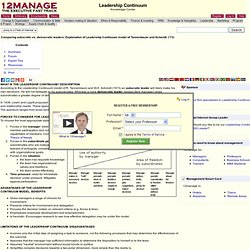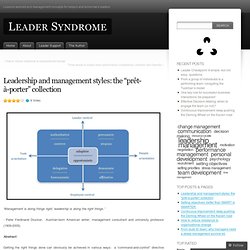

The six leadership styles at a glance. Leadership Styles - Leadership Skills From MindTools. Choosing the Right Approach for the Situation Find out what makes a great leader, with James Manktelow & Amy Carlson.

From Mahatma Gandhi and Winston Churchill, to Martin Luther King and Steve Jobs, there can be as many ways to lead people as there are leaders. Fortunately, businesspeople and psychologists have developed useful frameworks that describe the main ways that people lead. When you understand these frameworks, you can develop your own approach to leadership, and become a more effective leader as a result.
In this article, we'll highlight some of the common approaches to leadership that you can use. Note: These frameworks and styles of leadership are based on several different approaches to leadership. Useful Leadership Style Frameworks So, let's look at some useful approaches – shown mainly in the order they appeared – that you can use to become a more effective leader. Lewin's Leadership Styles The Blake-Mouton Managerial Grid The Blake-Mouton Managerial Grid Path-Goal Theory . . .
Six Emotional Leadership Styles - Leadership Training From MindTools. Choosing the Right Style for the Situation Find out how emotional leadership styles can affect your team's happiness. © iStockphoto/Kuklev Imagine that you work with a positive, charismatic leader.

She's excited about the future of the organization, and she shares this excitement with her team. She makes sure that people understand how their efforts contribute to this future, and this inclusion sparks loyalty and intense effort in the team. Generally, morale and job satisfaction are high, because team members feel that they're making a difference. However, some people in her team don't respond well to this style of leadership. She could be more effective by varying her approach to leadership, depending on the situation; and she could do this by using "six emotional leadership styles," each of which is useful in different circumstances. In this article, we'll look at these six emotional leadership styles. 6 Leadership Styles, And When You Should Use Them.
You don’t need an MP3 player, a turntable, or a CD player to listen to Tristan Perich’s new album, Noise Patterns.

All you need is a pair of headphones—"not earbuds," says the composer—and a willingness to hear music in noise. The 34-year-old Perich’s compositions push the border between white noise and electronic music, frequently straddling the two as if the static on your old television started emitting a strangely beautiful pattern of sound. But Perich doesn’t just compose music: His music is the instrument itself. He composes sound in code, carefully stringing together each 1 and 0 to transform numbers into a symphony. Perich, who studied math, music, and computer science at Columbia and received a masters from NYU's fabled hacking-meets-art Interactive Telecommunications Program, has spent the last dozen years of his life exploring the frontiers of one-bit sound, transforming those lines of 1s and 0s into a living art form. How to Choose a Leadership Pattern. Leadership Continuum. What is the Leadership Continuum?

Description According to the Leadership Continuum model of R. Tannenbaum and W.H. Schmidt (1973) an autocratic leader will likely make his own decisions. He will not delegate to his subordinates. In 1938, Lewin and Lippitt proposed classifications of leaders. Forces to consider for Leaders To choose the most appropriate style and use of authority, the leader should take into consideration: Forces in the manager: belief in team member participation and confidence in capabilities of members. Advantages of the Leadership Continuum Model. Gives managers a range of choices for involvement. Limitations of the Leadership Continuum. Involves only the initial step of assigning a task to someone, not the following processes that may determine the effectiveness of the outcome.
Authentic Leadership in Action. Servant Leadership. Leadership and Management Styles. “Management is doing things right; leadership is doing the right things.” - Peter Ferdinand Drucker, Austrian-born American writer, management consultant and university professor (1909-2005) Abstract: Getting the right things done can obviously be achieved in various ways: a “command-and-control” directive approach based on the manager’s exclusive expertise, a participative team discussion leveraging on everyone’s knowledge and skills, a path shown in a convincing and energetic manner by a charismatic leader… While it is important to know the various management and leadership styles with their respective advantages and drawbacks, it is also crucial to recognize that the best leaders are often the ones who can navigate from one style to another, depending on the context.

Download a one-page executive summary here (PDF format): Leadership and Management Styles Concept: Practice: exercise 1: To which quadrant of the leadership styles matrix do you belong to by default? So What? Leadership and Management Styles.